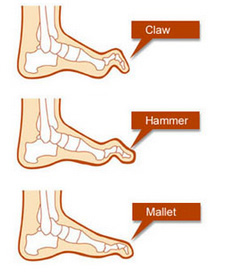in Foot and Ankle Surgery and Reconstruction
Hammer, mallet and claw toes are all variations on a theme. They describe certain patterns of bending deformity of the small toes in the foot. Depending on which of the small joints in the toe are abnormally bent and the manner in which they are bent will determine which name would correctly describe your toe problem.
 Injury to the toe can possibly cause damage to the tendons or tissue surrounding the toe joints, which can then gradually deform out of position. Ill-fitting shoe wear can potentially cause excessive pressure on the toes and lead them to bend upwards. If you have problems with the big toe for example a bunion, then you may develop problems with the 2nd toe (and others) because the bunion means you put more weight than normal on the smaller toes and the toe can deform as a result. Other important causes of toe deformities are congenitial nerve disorders such as Charcot Marie Tooth disease that can affect the pull of muscles and cause the toes to bend upwards. This is not likely unless both feet and all toes are affected and even then it is rare.
Injury to the toe can possibly cause damage to the tendons or tissue surrounding the toe joints, which can then gradually deform out of position. Ill-fitting shoe wear can potentially cause excessive pressure on the toes and lead them to bend upwards. If you have problems with the big toe for example a bunion, then you may develop problems with the 2nd toe (and others) because the bunion means you put more weight than normal on the smaller toes and the toe can deform as a result. Other important causes of toe deformities are congenitial nerve disorders such as Charcot Marie Tooth disease that can affect the pull of muscles and cause the toes to bend upwards. This is not likely unless both feet and all toes are affected and even then it is rare.
The commonest problem is pain on top of the toes because they rub on the shoes. Patients can often develop a callus or hard lump of skin on the knuckle of the toe as a result. On the sole of the foot the ball of the foot can also be painful and prominent and calluses can develop there too. This painful and prominent ball of the foot area is called metatarsalgia.
The clinical features described above where the toe is bent abnormally is quite easy to see on examination of the foot. X-Rays can be done to diagnose any associated problems in the foot such as a slightly long metatarsal bone or a bunion, which can cause secondary toe deformities.
People often live with the symptoms for many years before seeking medical attention. If you decide not to see your doctor, the problem will tend to progress, usually slowly. The calluses on the toes can become more painful and in some cases even ulcerate on the top of the toe. The toe can start out quite flexible with you being able to straighten it out with your hand but eventually it may become more rigid and bent.
The treatment can be operative or non-operative.
Non-operative treatment aims to accommodate your toe deformity in a shoe. This can be achieved by finding a shoe that is deep enough in the front to comfortably fit your toes. Special insoles can reduce the pressure sometimes seen on the ball of your foot. If these measures fail or your do not want to try them, surgery is always an option.
Operative treatment is designed to physically change the alignment of your toes so they lie straight when you stand. There are various options available. If the toe is quite flexible then tendon transfers (moving a tendon from the under-surface of the toe to the top surface of the toe) in the toe can pull your toe straight. This option is more common in children and adolescents. In adults the toes are often quite stiff.
The commonest way to deal with this problem in the UK is to perform a toe fusion procedure. This is a very successful operation and the toe lies nicely straight at the end and does not affect the function of your foot.
Many patients are simply seeking advice on managing a problem. In mild cases modifying shoes or activities can prove a successful therapy however if non-operative measures have failed to improve symptoms then surgery is indicated, and the timing of the surgery can be arranged to suit your needs.